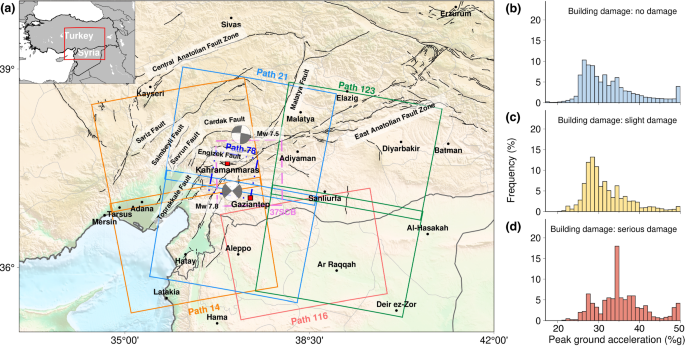Intelligent assessment of building damage of 2023 Turkey-Syria Earthquake by multiple remote sensing approaches – npj Natural Hazards
Türkoğlu, E., Unsworth, M., Bulut, F. & Çağlar, I. Crustal structure of the North Anatolian and East Anatolian Fault Systems from magnetotelluric data. Phys. Earth Planet. Inter. 241, 1–14 (2015).
Google Scholar
Alpyurur, M. & Lav, M. A. An assessment of probabilistic seismic hazard for the cities in Southwest Turkey using historical and instrumental earthquake catalogs. Nat. Hazards 114, 335–365 (2022).
Google Scholar
Nalbant, S. S., McCloskey, J., Steacy, S. & Barka, A. A. Stress accumulation and increased seismic risk in eastern Turkey. Earth Planet. Sci. Lett. 195, 291–298 (2002).
Google Scholar
Faccenna, C., Bellier, O., Martinod, J. & Piromallo, C. & Regard, V. Slab detachment beneath eastern Anatolia: A possible cause for the formation of the North Anatolian fault. Earth Planet. Sci. Lett. 242, 85–97 (2006).
Google Scholar
Emre, Ö. et al. Active fault database of Turkey. Bull. Earthq. Eng. 16, 3229–3275 (2018).
Google Scholar
The World Bank. Earthquake Damage in Türkiye Estimated to Exceed $34 billion: World Bank Disaster Assessment Report. The World Bank (2023).
USGS Geologic Hazards Science Center and Collaborators. The 2023 Kahramanmaraş, Turkey, Earthquake Sequence. (2023).
Melgar, D. et al. Sub- and super-shear ruptures during the 2023 Mw 7.8 and Mw 7.6 earthquake doublet in SE Türkiye. Seismica. 2 (2023).
Jiang, X., Song, X., Li, T. & Wu, K. Moment magnitudes of two large Turkish earthquakes on February 6, 2023 from long-period coda. Earthq. Science. 36, 169–174 (2023).
Shalal, A. World Bank estimates Feb. 6 earthquakes caused $34.2 bln in damage in Turkey. Reuters (2023).
Toksabay, E. & Butler, D. Turkey widens probe into building collapses as quake toll exceeds 50,000. Reuters (2023).
Leyendecker, E. V., Perkins, D. M., Algermissen, S. T., Thenhaus, P. C., & Hanson, S. L. USGS spectral response maps and their relationship with seismic design forces in building codes. (Open-File Report 95–596; Online only, Version 1.0) (1995).
Yang, S. et al. Analysis on public earthquake risk perception: based on questionnaire. In 3rd International Conference on Cartography and GIS (2010).
Xu, Q., Zhang, S. & Li, W. Spatial distribution of large-scale landslides induced by the 5.12 Wenchuan Earthquake. J. Mt. Sci. 8, 246–260 (2011).
Google Scholar
Yuan, Y., Zomorodian, S., Hashim, M. & Lu, Y. Devastating earthquakes facilitating civil societies in developing countries: across-national analysis. Environ. Hazards 17, 352–370 (2018).
Google Scholar
Fan, X. et al. Earthquake‐Induced Chains of Geologic Hazards: Patterns, Mechanisms, and Impacts. Rev. Geophys. 57, 421–503 (2019).
Google Scholar
Dell’Acqua, F. & Gamba, P. Remote Sensing and Earthquake Damage Assessment: Experiences, Limits, and Perspectives. Proc. IEEE 100, 2876–2890 (2012).
Google Scholar
Geiß, C. & Taubenböck, H. Remote sensing contributing to assess earthquake risk: from a literature review towards a roadmap. Nat. Hazards 68, 7–48 (2013).
Google Scholar
Joshi, G., Natsuaki, R. & Hirose, A. Neural-Network Fusion Processing and Inverse Mapping to Combine Multi-Sensor Satellite Data and Analyze the Prominent Features. IEEE J. Sel. Top. Appl. Earth Obs. Remote Sens. 16, 2819–2840 (2023).
Google Scholar
Xiong, C., Li, Q. & Lu, X. Automated regional seismic damage assessment of buildings using an unmanned aerial vehicle and a convolutional neural network. Autom. Constr. 109, 102994 (2020).
Google Scholar
Janalipour, M. & Mohammadzadeh, A. A novel and automatic framework for producing building damage map using post-event LiDAR data. Int. J. Disaster Risk Reduct. 39, 101238 (2019).
Google Scholar
Polcari, M. et al. Using multi-band InSAR data for detecting local deformation phenomena induced by the 2016–2017 Central Italy seismic sequence. Remote Sens. Environ. 201, 234–242 (2017).
Google Scholar
Stramondo, S., Bignami, C., Chini, M., Pierdicca, N. & Tertulliani, A. Satellite radar and optical remote sensing for earthquake damage detection: results from different case studies. Int. J. Remote Sens. 27, 4433–4447 (2006).
Google Scholar
Batool, S., Frezza, F., Mangini, F. & Simeoni, P. Introduction to Radar Scattering Application in Remote Sensing and Diagnostics: Review. Atmosphere 11, 517 (2020).
Google Scholar
Zhou, C. et al. Enhanced dynamic landslide hazard assessment using MT-InSAR method in the Three Gorges Reservoir Area. Landslides 19, 1585–1597 (2022).
Google Scholar
He, L. et al. Coseismic kinematics of the 2023 Kahramanmaras, Turkey earthquake sequence from INSAR and optical data. Geophys. Res. Lett. 50, e2023GL104693 (2023).
Google Scholar
Xu, X. et al. Surface deformation associated with fractures near the 2019 Ridgecrest earthquake sequence. Science 370, 605–608 (2020).
Google Scholar
Song, C. et al. Triggering and recovery of earthquake accelerated landslides in Central Italy revealed by satellite radar observations. Nat. Commun. 13, 7278 (2022).
Google Scholar
Arciniegas, G., Bijker, W., Kerle, N. & Tolpekin, V. A. Coherence- and Amplitude-Based Analysis of Seismogenic Damage in Bam, Iran, Using ENVISAT ASAR Data. IEEE Trans. Geosci. Remote Sens. 45, 1571–1581 (2007).
Google Scholar
Yun, S. H. et al. Rapid Damage Mapping for the 2015 Mw 7.8 Gorkha Earthquake Using Synthetic Aperture Radar Data from COSMO–SkyMed and ALOS-2 Satellites. Seismol. Res. Lett. 86, 1549–1556 (2015).
Google Scholar
Xu, S., Dimasaka, J., Wald, D. J. & Noh, H. Y. Seismic multi-hazard and impact estimation via causal inference from satellite imagery. Nat. Commun. 13, 7793 (2022).
Google Scholar
Yu, X., Hu, X., Wang, G., Wang, K. & Chen, X. Machine‐Learning Estimation of Snow Depth in 2021 Texas Statewide Winter Storm Using SAR Imagery. Geophys. Res. Lett. 49, e2022GL099119 (2022).
Google Scholar
Hu, X., Bürgmann, R., Fielding, E. J., Xu, X. & Zhen, L. Machine-learning characterization of tectonic, hydrological and anthropogenic sources of ground deformation in California. J. Geophys. Res. Solid Earth 126, e2021JB022373 (2021).
Google Scholar
Madadi, M. R., Azamathulla, H. M. & Yakhkeshi, M. Application of Google earth to investigate the change of flood inundation area due to flood detention dam. Earth Sci. Inform 8, 627–638 (2015).
Google Scholar
Ahn, D. et al. A human-machine collaborative approach measures economic development using satellite imagery. Nat Commun 14, 6811 (2023).
Google Scholar
Wang, C. et al. Causality-informed Rapid Post-hurricane Building Damage Detection in Large Scale from InSAR Imagery. Proceedings of the 8th ACM SIGSPATIAL International Workshop on Security Response using GIS, 7–12 (2023).
Yu, X., Wang, G., Hu, X., Liu, Y. & Bao, Y. Land subsidence in Tianjin, China: Before and after the South-to-North Water Diversion. Remote Sens. 15, 1647 (2023).
Google Scholar
Robinson, C. et al. Turkey Building Damage Assessment. Microsoft (2023).
Li, X. et al. DisasterNet: Causal Bayesian Networks with normalizing flows for cascading hazards estimation fromsatellite imagery. Proceedings of the 29th ACM SIGKDD Conference on Knowledge Discovery and Data Mining, 4391–4403 (2023).
Xu, S., Dimasaka, J., Wald. D. J., & Noh, H. Y. Seismic multi-hazard and impact estimation via causal inference from satellite imagery. Nat. Commun. 13, 7793 (2022).
Douglas, J. Earthquake ground motion estimation using strong-motion records: a review of equations for the estimation of peak ground acceleration and response spectral ordinates. Earth-Sci. Rev. 61, 43–104 (2003).
Google Scholar
Arjun, C. & Kumar, A. Artificial neural network-based estimation of peak ground acceleration. ISET J. Earthq. Technol. 501, 46 (2009).
Montilla, J. A. P., Hamdache, M. & Casado, C. L. Seismic hazard in Northern Algeria using spatially smoothed seismicity. Results for peak ground acceleration. Tectonophysics 372, 105–119 (2003).
Google Scholar
Barnhart, W. D., Brengman, C. M. G., Li, S. & Peterson, K. E. Ramp-flat basement structures of the Zagros Mountains inferred from co-seismic slip and afterslip of the 2017 Mw7.3 Darbandikhan, Iran/Iraq earthquake. Earth Planet. Sci. Lett. 496, 96–107 (2018).
Google Scholar
Hason, M. M., Hanoon, A. N. & Abdulhameed, A. A. Particle swarm optimization technique based prediction of peak ground acceleration of Iraq’s tectonic regions. J. King Saud Univ. Eng. Sci. 35, 463–473 (2021).
Wirth, E. A., Grant, A., Marafi, N. A. & Frankel, A. E. Ensemble ShakeMaps for Magnitude 9 Earthquakes on the Cascadia Subduction Zone. Seismol. Res. Lett. 92, 199–211 (2021).
Google Scholar
Frankel, A. E., Wirth, E. A., Marafi, N. A., Vidale, J. E. & Stephenson, W. J. Broadband Synthetic Seismograms for Magnitude 9 Earthquakes on the Cascadia Megathrust Based on 3D Simulations and Stochastic Synthetics, Part 1: Methodology and Overall Results. Bull. Seismol. Soc. Am. 108, 2347–2369 (2018).
Google Scholar
Athanasopoulos, G., Pelekis, P. C. & Leonidou, E. Effects of surface topography on seismic ground response in the Egion (Greece) 15 June 1995 earthquake. Soil Dyn. Earthq. Eng. 18, 135–149 (1999).
Google Scholar
Ma, S., Archuleta, R. J. & Page, M. T. Effects of Large-Scale Surface Topography on Ground Motions, as Demonstrated by a Study of the San Gabriel Mountains, Los Angeles, California. Bull. Seismol. Soc. Am. 97, 2066–2079 (2007).
Google Scholar
Zonno, G. et al. Assessing Seismic Damage Through Stochastic Simulation of Ground Shaking: The Case of the 1998 Faial Earthquake (Azores Islands). Surv. Geophys. 31, 361–381 (2010).
Google Scholar
Toppozada, T. R. Earthquake magnitude as a function of intensity data in California and Western Nevada. Bull. Seismol. Soc. Am. 65, 1223–1238 (1975).
Kanamori, H. Quantification of Earthquakes. Nature 271, 411–414 (1978).
Google Scholar
Lee, K. & Monge, E. J. Effect of soil conditions on damage in the Peru earthquake of October 17, 1966. Bull. Seismol. Soc. Am. 58, 937–962 (1968).
Google Scholar
Dalgıç, S. Factors affecting the greater damage in the Avcılar area of Istanbul during the 17 August 1999 Izmit earthquake. Bull. Eng. Geol. Environ. 63, 221–232 (2004).
Google Scholar
Seed, H. B. & Lee, K. Liquefaction of Saturated Sands During. Cyclic Loading. J. Soil Mech. Found. Div. 92, 105–134 (1966).
Google Scholar
Wang, C., Wong, A., Dreger, D. S. & Manga, M. Liquefaction Limit during Earthquakes and Underground Explosions: Implications on Ground-Motion Attenuation. Bull. Seismol. Soc. Am. 96, 355–363 (2006).
Google Scholar
Wang, Y., Feng, W., Chen, K. & Samsonov, S. Source Characteristics of the 28 September 2018 Mw 7.4 Palu, Indonesia, Earthquake Derived from the Advanced Land Observation Satellite 2 Data. Remote Sens. 11, 1999 (2019).
Google Scholar
Pratama, A., Fathani, T. F. & Satyarno, I. Liquefaction potential analysis on Gumbasa Irrigation Area in Central Sulawesi Province after 2018 earthquake. IOP Conf. 930, 012093 (2021).
Dong, L. & Shan, J. A comprehensive review of earthquake-induced building damage detection with remote sensing techniques. ISPRS J. Photogramm. Remote Sens. 84, 85–99 (2013).
Google Scholar
Zhang, Y., Roffey, M. & Leblanc, S. G. A Novel Framework for Rapid Detection of Damaged Buildings Using Pre-Event LiDAR Data and Shadow Change Information. Remote Sens 13, 3297 (2021).
Google Scholar
NISAR. NASA-ISRO SAR (NISAR) Mission science users’ handbook. NASA Jet Propulsion Laboratory. (2018).
Li, P., Song, B. & Xu, H. Urban building damage detection from very high-resolution imagery by One-Class SVM and shadow information. Int. Geosci. Remote Sens. Symp. 1409-1412 (2011).
Yazilim, G., Cizenler, Y. & Haritası, I. 2023 Turkey Earthquakes – Building Damage Assessment Map (2023).
Tracy, K. C., Mosalam, K., Prevatt, D., Robertson, I. & Roueche, D. StEER-February 6, 2023, Kahramanmaras, Türkiye, Mw 7.8 Earthquake. DesignSafe-CI (2023).
Touzi, R., Lopes, A., Bruniquel, J. & Vachon, P. W. Coherence estimation for SAR imagery. IEEE Trans. Geosci. Remote Sens. 37, 135–149 (1999).
Google Scholar
López-Martínez, C. & Pottier, E. Coherence estimation in synthetic aperture radar data based on speckle noise modeling. Appl. Opt. 46, 544–558 (2007).
Google Scholar
Zebker, H. A. & Villasenor, J. Decorrelation in interferometric radar echoes. IEEE Trans. Geosci. Remote Sens. 30, 950–959 (1992).
Google Scholar
Hoen, E. W. & Zebker, H. A. Penetration depths inferred from interferometric volume decorrelation observed over the Greenland Ice Sheet. IEEE Trans. Geosci. Remote Sens. 38, 2571–2583 (2000).
Google Scholar
Rott, H., Nagler, T. & Scheiber, R. Snow mass retrieval by means of SAR interferometry. Proceedings of the FRINGE 2003 Workshop (ESA SP-550) (2003).
Closson, D. & Milisavljevic, N. Mine Action – The Research Experience of the Royal Military Academy of Belgium 6 (IntechOpen, 2017).
Massonnet, D. & Feigl, K. L. Radar interferometry and its application to changes in the Earth’s surface. Rev. Geophys. 36, 441–500 (1998).
Google Scholar
Sandwell, D., Mellors, R., Tong, X., Wei, M. & Wessel, P. Open Radar Interferometry Software for Mapping Surface Deformation. Eos Trans. AGU 92, 234 (2011).
Google Scholar
Horn, B. K. P., Woodham, R. J. & Destriping, L. A. N. D. S. A. T. MSS Images by Histogram Modification. Comput. Graph. Image Process. 10, 69–83 (1979).
Google Scholar
Castleman, K. R. Digital image processing (Prentice-Hall, New Jersey, 1996).
Gonzalez, R. C. & Woods, R. E. Digital Image Processing (3rd Edition) (Prentice-Hall, New Jersey, 2006).
Ferretti, A., Prati, C. & Rocca, F. Permanent scatterers in SAR interferometry. IEEE Trans. Geosci. Remote Sens. 39, 8–20 (2001).
Google Scholar
Esmaeili, M. & Motagh, M. Improved Persistent Scatterer analysis using Amplitude Dispersion Index optimization of dual polarimetry data. ISPRS J. Photogramm. Remote Sens. 117, 108–114 (2016).
Google Scholar
Zha, Y., Gao, J. & Ni, S. Use of normalized difference built-up index in automatically mapping urban areas from TM imagery. Int. J. Remote Sens. 24, 583–594 (2003).
Google Scholar
Hu, Y. & Tang, H. X. On the Generalization Ability of a Global Model for Rapid Building Mapping from Heterogeneous Satellite Images of Multiple Natural Disaster Scenarios. Remote Sens. 13, 984 (2021).
Google Scholar
Shao, X. et al. Planet Image-Based Inventorying and Machine Learning-Based Susceptibility Mapping for the Landslides Triggered by the 2018 Mw6.6 Tomakomai, Japan Earthquake. Remote Sens. 11, 978 (2019).
Google Scholar
Fawcett, T. An introduction to ROC analysis. Pattern Recognit. Lett. 27, 861–874 (2006).
Google Scholar
Alatorre, L. C., Sánchez-Andrés, R., Cirujano, S., Beguería, S. & Sánchez-Carrillo, S. Identification of Mangrove Areas by Remote Sensing: The ROC Curve Technique Applied to the Northwestern Mexico Coastal Zone Using Landsat Imagery. Remote Sens. 3, 1568–1583 (2011).
Google Scholar
Chang, Z. et al. Landslide Susceptibility Prediction Based on Remote Sensing Images and GIS: Comparisons of Supervised and Unsupervised Machine Learning Models. Remote Sens. 12, 502 (2020).
Google Scholar
Pedregosa et al. Scikit-learn: Machine Learning in Python. J. Mach. Learn. Res. 12, 2825–2830 (2011).
Google Scholar




